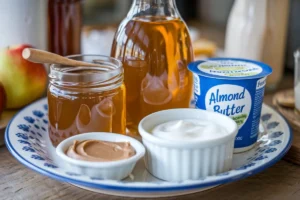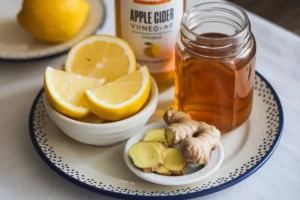Gastroesophageal reflux disease (GERD) is a common digestive disorder that affects millions of people worldwide. Managing GERD often involves making significant changes to one’s diet, including being mindful of the condiments used. Certain condiments can exacerbate GERD symptoms, while others are safer options that can enhance the flavor of your food without causing discomfort. In this comprehensive guide, we’ll explore the best condiments to use if you have GERD, as well as tips on how to incorporate them into your meals.
Understanding GERD and Its Triggers
Before diving into the specifics of condiments, it’s important to understand what GERD is and what triggers it. GERD occurs when the lower esophageal sphincter (LES), a ring of muscle between the esophagus and stomach, weakens or relaxes inappropriately, allowing stomach acid to flow back into the esophagus. This acid reflux can cause a burning sensation known as heartburn, as well as other symptoms like regurgitation, chest pain, and difficulty swallowing.
Common Triggers of GERD:
- Spicy foods: Foods with a high level of spiciness can irritate the lining of the esophagus, leading to increased acid production.
- Fatty foods: High-fat foods can cause the LES to relax, making it easier for acid to escape into the esophagus.
- Citrus fruits: Citrus fruits and juices are acidic and can increase acid production in the stomach.
- Tomato-based products: Tomatoes are naturally acidic and can exacerbate GERD symptoms.
- Onions and garlic: These common ingredients can cause the LES to relax and increase the risk of acid reflux.
Now that we have a basic understanding of GERD and its triggers, let’s delve into the world of condiments that are safe to use if you suffer from this condition.
Best Condiments for GERD

When choosing condiments, the key is to opt for those that are low in acid, fat, and spiciness. Here are some condiments that are generally safe for people with GERD:
Mustard
Mustard is a low-fat condiment that can be used to add flavor to a variety of dishes. However, it’s important to choose mild mustard varieties rather than spicy or Dijon mustards, which may contain more irritating ingredients like vinegar or additional spices. Yellow mustard, for example, is often tolerated well by those with GERD.
Herbs and Spices (Non-spicy)
Fresh and dried herbs like basil, oregano, parsley, and thyme can add flavor to your meals without triggering GERD symptoms. These herbs are low in fat and acid and can be used to season everything from meats to vegetables. Just be sure to avoid spicy herbs and spices like chili powder and black pepper, as these can exacerbate GERD symptoms.
Low-Fat Yogurt or Greek Yogurt
Yogurt, particularly low-fat or non-fat varieties, can be a soothing condiment for GERD sufferers. It can be used as a base for dressings, dips, or even as a topping for baked potatoes. The probiotics in yogurt may also help support digestive health, though individual tolerance can vary.
Apple Cider Vinegar (in Small Amounts)
While vinegar is generally acidic and should be avoided, some people find that small amounts of apple cider vinegar can help alleviate their GERD symptoms. It’s thought that apple cider vinegar may help balance stomach acid levels. If you choose to try apple cider vinegar, start with a small amount and see how your body responds.
Honey
Honey is a natural sweetener that is less likely to trigger GERD symptoms compared to sugar or artificial sweeteners. It can be used to sweeten teas, dressings, or desserts. Manuka honey, in particular, is known for its soothing properties and may be beneficial for the digestive tract.
Low-Fat or Fat-Free Salad Dressings
Many salad dressings are high in fat, which can trigger GERD symptoms. Opt for low-fat or fat-free versions, and consider making your own at home using safe ingredients like olive oil, lemon juice, and herbs. Be cautious with creamy dressings, as they often contain high-fat ingredients like mayonnaise or sour cream.
Olive Oil
Olive oil is a healthy fat that is generally well-tolerated by those with GERD. It can be used as a base for dressings, drizzled over vegetables, or used in cooking. However, it’s still important to use olive oil in moderation, as large amounts of any fat can trigger GERD symptoms.
Tahini
Tahini is a paste made from ground sesame seeds and is commonly used in Middle Eastern cuisine. It’s a rich source of healthy fats and can be used as a spread or mixed into sauces. Since it’s not highly acidic or spicy, it’s usually a safe option for those with GERD, though it should still be consumed in moderation.
Pesto (Without Garlic)
Traditional pesto contains garlic, which can be a trigger for GERD. However, you can make or buy garlic-free pesto that’s made with basil, pine nuts, olive oil, and Parmesan cheese. This can be a flavorful addition to pasta, sandwiches, or salads without causing discomfort.
Hummus (without Garlic)
Hummus is another Mediterranean favorite that can be enjoyed by GERD sufferers if prepared without garlic. This creamy dip, made from chickpeas, tahini, and olive oil, is high in fiber and healthy fats. Pair it with non-acidic vegetables or whole grain crackers for a satisfying snack.
Condiments to Avoid with GERD

Just as important as knowing what condiments are safe for GERD is understanding which ones to avoid. Certain condiments can significantly worsen GERD symptoms and should be limited or eliminated from your diet. Here’s a list of condiments that are best avoided:
Ketchup
Ketchup is a common condiment, but it’s one that GERD sufferers should steer clear of. Made primarily from tomatoes, which are highly acidic, ketchup can easily trigger heartburn and other symptoms of GERD. Additionally, ketchup often contains added sugar, which can also contribute to acid reflux.
Barbecue Sauce
Barbecue sauce is another condiment that’s best avoided if you have GERD. This sauce often contains a mix of tomatoes, vinegar, and various spices, making it a potent trigger for acid reflux. Even small amounts can cause significant discomfort, so it’s best to skip this one.
Mayonnaise
Mayonnaise is high in fat, which can relax the LES and make it easier for stomach acid to flow back into the esophagus. For this reason, it’s best to avoid mayonnaise or use it sparingly if you have GERD. If you must use it, opt for a low-fat version and use it in small amounts.
Hot Sauce
Hot sauce is a major trigger for GERD due to its high level of spiciness. Capsaicin, the compound that makes peppers hot, can irritate the esophagus and increase stomach acid production. If you enjoy spicy foods, it’s best to find milder alternatives or use other seasonings to add flavor without the heat.
Salsa
Salsa, particularly those made with tomatoes and onions, is another condiment to avoid. Both tomatoes and onions are known triggers for GERD, and the combination of the two in salsa can be especially problematic. If you’re craving something similar, consider making a mild, non-tomato-based salsa using ingredients like cucumber, cilantro, and lime juice.
Vinegar-Based Dressings
Vinegar is highly acidic and can easily trigger GERD symptoms. Many salad dressings, especially vinaigrettes, are vinegar-based and should be avoided. As mentioned earlier, you can opt for dressings made with olive oil, lemon juice, and herbs as a safer alternative.
Horseradish
Horseradish is another spicy condiment that can irritate the esophagus and lead to increased acid production. It’s best to avoid horseradish if you have GERD, as it can quickly trigger symptoms even in small amounts.
Soy Sauce
Soy sauce is high in sodium and contains fermented soybeans, both of which can aggravate GERD symptoms. Additionally, soy sauce is often used in combination with other high-sodium or acidic ingredients, which can further exacerbate symptoms. Consider using a low-sodium alternative or coconut aminos, though individual tolerance may vary.
Tips for Enjoying Condiments with GERD

Even if you have GERD, you don’t have to give up on condiments entirely. By making smart choices and using condiments in moderation, you can still enjoy flavorful meals without the discomfort of acid reflux. Here are some tips for incorporating condiments into your GERD-friendly diet:
- Portion ControlEven safe condiments can cause issues if consumed in large quantities. Start with a small amount of any condiment and see how your body reacts before adding more. This can help you avoid triggering symptoms and still enjoy the flavors you love.
- DIY CondimentsMaking your own condiments at home allows you to control the ingredients and adjust them to suit your needs. For example, you can create a GERD-friendly salad dressing using olive oil, lemon juice, and your favorite herbs. You can also experiment with different flavor combinations to find what works best for you.
- Choose Fresh Over ProcessedFresh herbs and homemade condiments are generally safer than processed, store-bought options. Processed condiments often contain added sugars, preservatives, and other ingredients that can trigger GERD symptoms. Whenever possible, opt for fresh ingredients and make your own condiments to ensure they’re GERD-friendly.
- Experiment with FlavorsJust because you have GERD doesn’t mean your food has to be bland. Experiment with different flavors and combinations of herbs, spices, and condiments to keep your meals interesting. For example, try adding fresh basil to your pasta instead of tomato sauce or using yogurt as a base for a creamy, non-spicy dressing.
- Be Mindful of Hidden IngredientsAlways read labels carefully to check for hidden ingredients that could trigger GERD symptoms. Even condiments that seem safe can contain small amounts of spicy or acidic ingredients. If you’re unsure about a particular condiment, it’s best to err on the side of caution and avoid it.
Frequently Asked Questions
1. Can I use lemon juice as a condiment if I have GERD?
Lemon juice is highly acidic and can easily trigger GERD symptoms. While some people with GERD may tolerate small amounts of lemon juice, it’s generally best to avoid it, especially in concentrated forms like dressings or marinades. Instead, you can use herbs, olive oil, or a small amount of apple cider vinegar as a safer alternative.
2. Is it safe to use butter as a condiment with GERD?
Butter is high in fat, which can relax the LES and exacerbate GERD symptoms. While small amounts may be tolerated by some individuals, it’s generally recommended to limit or avoid butter if you have GERD. Consider using olive oil or a low-fat spread as a healthier alternative.
3. Are there any GERD-friendly alternatives to soy sauce?
Yes, there are a few alternatives to soy sauce that may be better tolerated by those with GERD. Coconut aminos, for example, is a soy-free, lower-sodium alternative that can be used in place of soy sauce. However, individual tolerance can vary, so it’s important to start with a small amount and monitor your symptoms.
4. Can I use garlic-infused oil if I have GERD?
Garlic is a common trigger for GERD, but garlic-infused oil may be better tolerated by some individuals. The infusion process typically involves cooking garlic in oil and then removing the garlic, leaving behind the flavor without the irritating compounds. If you find that garlic-infused oil works for you, it can be a flavorful addition to your meals.
5. Is there a GERD-friendly way to enjoy mayonnaise?
Mayonnaise is high in fat, which can trigger GERD symptoms. However, you can make a GERD-friendly version at home using low-fat or fat-free ingredients. For example, you can mix low-fat yogurt with a small amount of mustard and lemon juice to create a creamy, tangy spread that’s less likely to cause discomfort.
6. Can I use store-bought dressings if I have GERD?
Many store-bought dressings contain ingredients that can trigger GERD, such as vinegar, onions, or high-fat ingredients. It’s best to make your own dressings at home so you can control the ingredients. If you do choose to use store-bought dressings, look for ones that are low-fat, vinegar-free, and made with GERD-friendly ingredients.
Conclusion
Living with GERD doesn’t mean you have to sacrifice flavor in your meals. By carefully selecting condiments that are low in fat, acid, and spiciness, you can continue to enjoy your favorite dishes without the discomfort of acid reflux. Remember to start with small amounts, monitor your symptoms, and be mindful of the ingredients in your condiments. With these tips in mind, you can create a delicious, GERD-friendly diet that supports your overall health and well-being.

